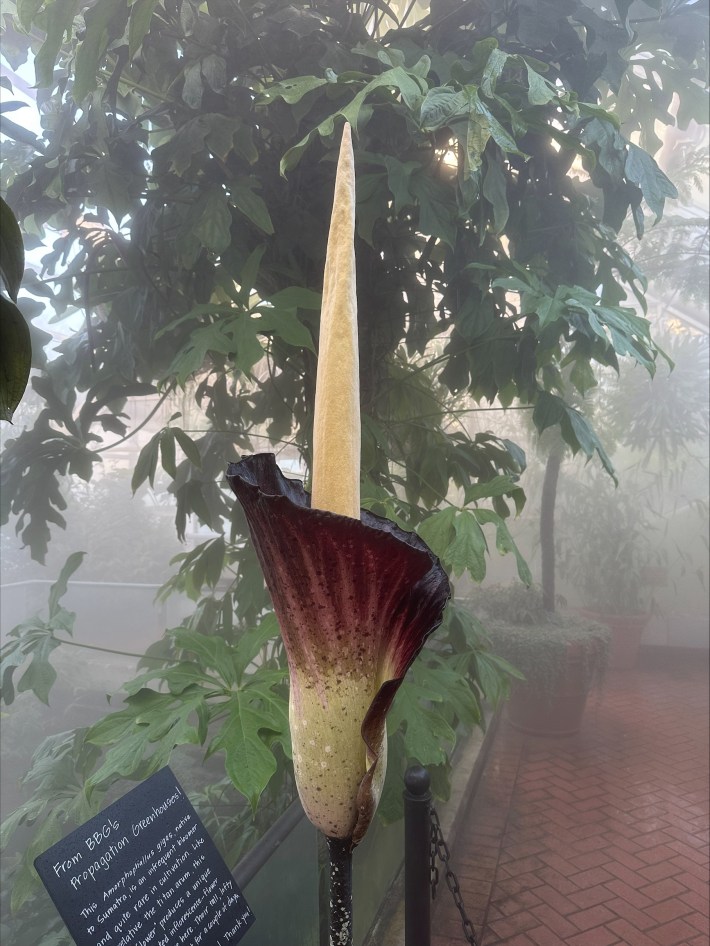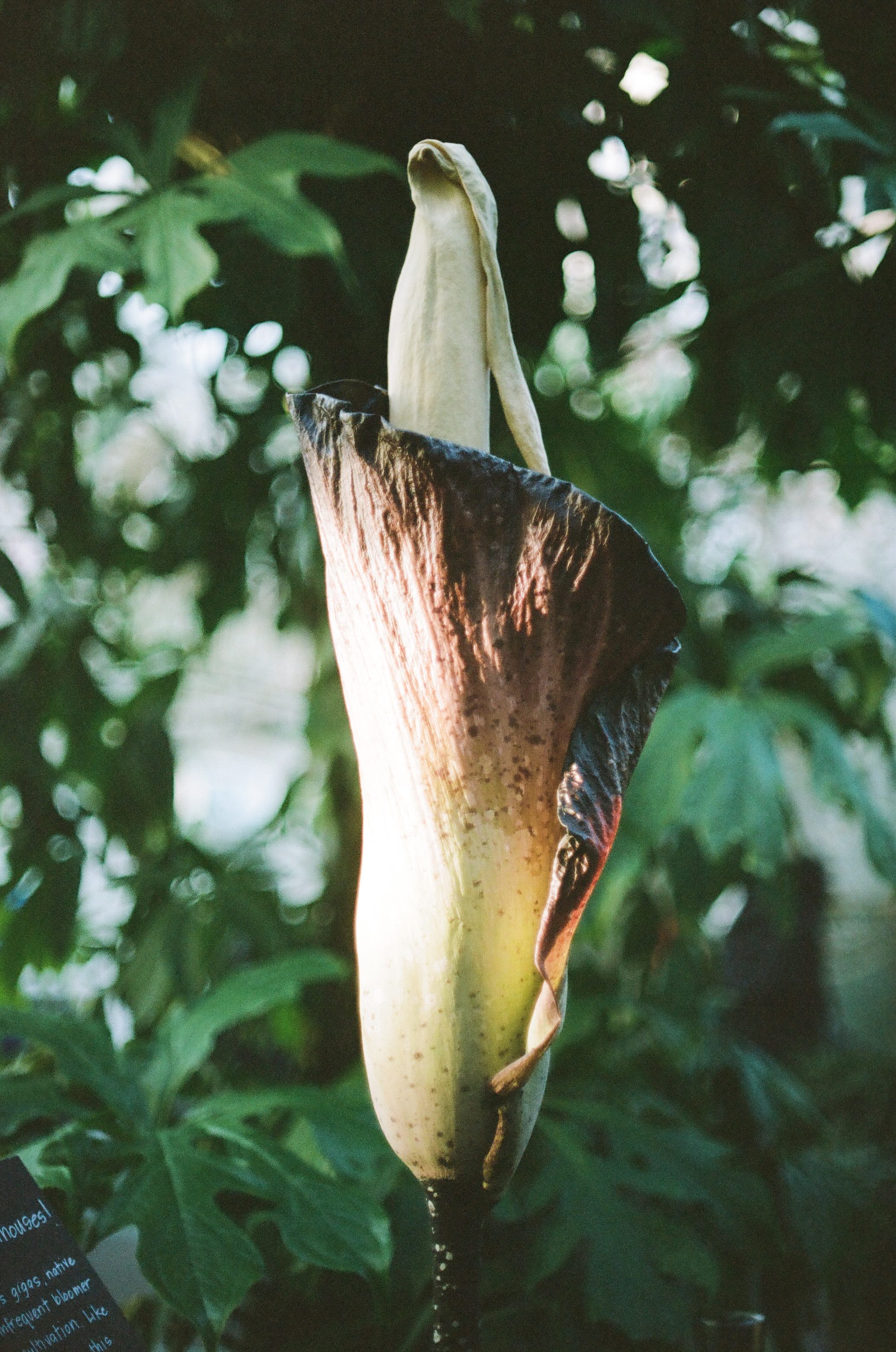Standing five feet away, I could smell it in the air. Acrid, damp, toe-curling—a memory from my past. The nose is a powerful historian, so it took only a few seconds to place it: the stench of the rat that died in the walls of my second apartment in New York City. Because management was hesitant to punch a hole in the sheetrock to retrieve it, the corpse dried out slowly, rendering one bedroom unlivable as my roommate slept on the sofa and recouped a few weeks of rent. It had been a long time since I smelled that smell. Most Proustian reveries originating in Bushwick won't transport you anywhere you want to go. I got a little closer to smell it again.
I was among thousands of curious sniffers. Visitors queued up for hours at the Brooklyn Botanic Garden in late January to see the magnificent Amorphophallus gigas and its so-called “corpse flower,” nicknamed for the aroma it emits to entice its pollinators. On its native Indonesian island of Sumatra, the plant attracts eager carrion beetles and dung beetles. Here in Brooklyn, it attracts common house flies, smaller unidentified gnats, and Homo sapiens who are enthusiastic about botany and foul odors. This particular plant arrived at the Garden in 2018 from Malaysia. It is rare in cultivation; only nine other botanic gardens have one on their rosters. This one had never bloomed before.
A. gigas cycles in and out of dormancy. Every 18 months or so, this plant shoots up exactly one complex, umbrella-shaped, segmented leaf. Then that leaf dies down, leaving nothing aboveground, just the plant’s corm, its fat tuber, working away in the soil. Eventually the corm shoots up another leaf to do a little more photosynthesizing. Once the corm finally accumulates enough energy, it can attempt something more ambitious than a leaf.
Late last year, a new cycle of growth began. Sometime between Christmas and New Year's in 2024, gardener Chris Sprindis realized that the plant was not producing a mere leaf, and was starting to bulge a little bit more than usual. It was readying itself to bloom for the first time. Topped by a tightly wrapped spike, the plant grew furiously. By late December, it began to ascend two or three inches a day.
Because A. gigas is so rare in cultivation, Sprindis took some plant-care cues from its grander, flashier prima-donna cousin, A. titanum. And in a wonderful bit of web archaeology, he discovered that a Florida botanic garden had cared for some blooming A. gigas plants back in 1999 and kept a detailed timeline of their growth. Sprindis hopes to help out other gardens in the future by sharing his own experiences, contributing to the lore of fetid plant care.
Roughly four weeks after he first noticed A. gigas was going to bloom, sometime between Jan. 23 and 24, that spike unfurled and inflicted its stink on anyone within range. Technically what the plant produces is not a single standalone flower but an inflorescence, a cluster of hundreds of tiny flowers, not easily seen from the outside. What catches the eye instead are the plant's two largest organs. The first is the spadix, a baby-yellow spike that shoots up along the same vertical plane as the plant’s stem. Curled around that spike is the spathe, the thick petal-like sheath, leathery and mottled as if with liver spots. The spathe's colors, which blend from a pale spring green to a bloody dark wine, are thought to evoke rotting meat for the pollinators, working in tandem with the smells.
Propping up this bloom from below is a stalk known as a peduncle, a really enjoyable word to say. Sprindis had read a cool hypothesis about the peduncle's patchy appearance: It had evolved to trick animals into thinking that it was a lot hardier than it actually was, by mimicking the hues of lichens. "It takes a long time for lichen to form, so they only form on tree trunks that have been around for a while, and for an animal walking through the woods, they would register that pattern as growing on something sturdy, and they would instinctively know to avoid it," he said. "It's a way for the plant to not get itself knocked over, by looking like it can't be knocked over." In fact, a blooming A. gigas is precariously top-heavy and delicate; visitors weren't allowed to touch it. At about 6 feet tall, A. gigas could only defend the one and would struggle in a switching scheme.
The inflorescence would only last for a few days at full potency, so visitors clamored for a chance to sniff. By the time I arrived in the late afternoon on Jan. 24, the spathe had already flopped over, like the nightcap of a pajama-clad man holding a candlestick. Amorphophallus gigas translates to “giant shapeless phallus,” a fact that didn't get enough attention in the garden’s signage, in my opinion. At the base beneath the spathe were the actual, tiny flowers, bright yellow and green, each one about the size of a sesame seed, hoping to attract insects. There was a tier of male flowers above a tier of female flowers, and their blooming times were staggered, so that the plant did not accidentally pollinate itself. That’s where most of the aroma was emanating from.

God, that aroma. City dwellers enjoy a variety of rank odors over the course of their day, but this had most of them beat. When I went up and put my nose over the opening of the spathe, the first note was recognizably floral, and not that unpleasant. An overripe, perfumed smell, something like the petals rotting at the bottom of a florist’s truck bed. A second inhale offered a thin, genuinely pleasant floral note, untainted by any evil. Then, on my next deeper inhale: dead rat again. It was nasal Russian roulette. One BBG staffer I spoke to described her tasting notes over the course of the day: dog-breath morning, dog-poop afternoon, stinky-cheese evening. By the time the garden closed I too was beginning to pick up on some of that marshy, soft Limburger.
The following day, a Saturday, garden visitors formed a long line that snaked up a slope and looped around the lily pond. The high outside was 28 degrees, and they were waiting for the privilege to duck inside the conservatory that is typically in the 80s and low 90s during the day, thick with tropical humidity that will steam up glasses. Once they got to the front of the line, they inhaled, posed, and moved on, as if paying their respects to a malodorous pope. Some sniffed and nodded, as if happy. Some leaned into the bloom and tottered as if socked. Heads jerked back; eyes narrowed. Babies were held up to the inflorescence only to recoil. Small children claimed they could smell it from feet away and refused a closer sniff.
Shorter visitors, who leaned in and smelled the outside of the spathe, never got the real deathly aroma emanating from the bottom. They wondered what the big deal was. A step stool would have helped them take in the smell in all its glory; they’d already waited two hours for that privilege. One security guard joked to the other that they should be lifting up the shorter patrons. As for his personal favorite response, Sprindis told me he saw a woman hold a jar above the plant and quickly seal it. He chased after her, not to chastise her but because he was curious. "She was like, My friend isn't going to be back for a week, and he wants to smell it, so I'm hoping that I trap some of the smell."

The tasting notes of A. gigas were different on my second visit. The smell was a little less acrid and a little more humid and sweaty, at once synthetic and organic, like I'd poked my nose into the inside of a rubber glove that had been used to mash bananas for hours. I lingered by the flower for a while and listened to others' descriptions: burnt rubber, “my feet after a long day of work,” old fish, the funk of body odor, the subway, halitosis. A surprising number of people confidently cited dead bodies, which made me wonder about their professions or hobbies. On my way out I could have sworn the aroma was lingering on me somehow, as if it had infiltrated the cotton of my sweatshirt. Perhaps I just had bad breath from not eating or drinking anything for several hours while exploring the gardens; the taste at the back of my tongue was such a convincing echo of what had struck my nose in the bloom.
I thought I was losing it, but Sprindis told me his experience was similar. “I had changed my clothes, and I had showered, and I could still smell it. I think it gets either inside your nose or it gets under on body hair,” he said. “There’s something about these compounds, I think, that are able to cling for some reason.” Maybe the woman with the jar was onto something. A 2011 study analyzed the liquid emitted by an A. gigas inflorescence in Tokyo and discovered that its main components were acetic acid (the main component of vinegar), propionic acid (there’s the body odor), butyric acid (more vomitous, if you’ve stepped over fallen ginkgo fruit), and valeric acid (sour milk).
After unfurling at full potency on a Friday, the aroma was still discernible on Tuesday or Wednesday, Sprindis recalled, and then it faded. It was considerate of A. gigas to bloom on a weekend: From Friday through Sunday, over 8,000 people arrived to inhale dead-rat funk, compared to 1,200 for that weekend in the previous year. While the springtime cherry blossom festival is the Brooklyn Botanic Garden's biggest draw, that's a whole army of trees; Sprindis told me that no single plant had attracted so much attention in his time there. I was moved by this vision of my fellow screen-addicted citizens cozying up to this repulsive plant, to take in an unmediated sensory experience.
At time of writing, the inflorescence is collapsing and drying out. The peduncle remains rigid a bit longer, but eventually it too will collapse, at which point Sprindis plans to cut it off at the soil line. This bloom had been eight or nine years in the making. After such a ridiculous energy expenditure, the hard work of a near-decade, I wondered: Did the plant seem at all … tired? Sprindis said that the corm actually shrinks after shooting up a bloom. Over the last year or two, he had been using a high-phosphorus fertilizer which is supposed to benefit corm growth. Once it is dormant again, the corm can be safely repotted and moved to a slightly bigger pot to give it more room to grow. When the plant is in leaf, he'll keep the soil wetter, and drier when it's sleeping. Someday, it will bloom again. And once it's stinky, they will come.






